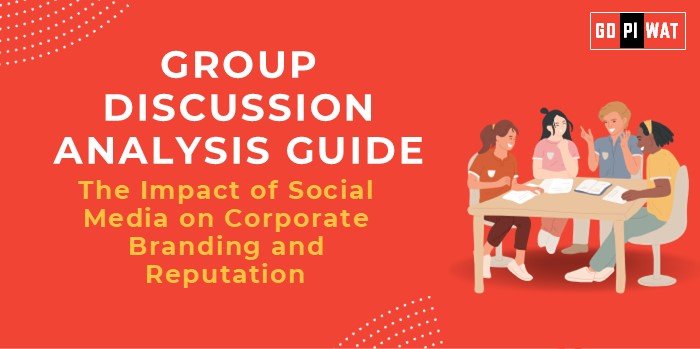📋 Group Discussion (GD) Analysis Guide
🌐 Topic: The Impact of Social Media on Corporate Branding and Reputation
💡 Introduction to the Topic
Social media has fundamentally reshaped corporate branding and reputation management in the 21st century. It provides businesses with direct access to consumers while simultaneously placing their reputations at the mercy of public opinion in real-time. For B-school aspirants, understanding this dual-edged sword is crucial, as it highlights the intersection of marketing, crisis management, and stakeholder engagement in a digital-first global economy. Analyzing its influence also builds insight into leveraging technology for sustainable brand equity while navigating potential pitfalls.
📊 1. Comprehensive Quick Facts and Data Significance
- Global Social Media Users: 4.89 billion (2024) 🌍
This number represents over half of the global population, indicating how integral social media has become to human interaction and brand outreach.
Suggested Visual: A global map highlighting user density across regions.
- Consumer Behavior: 54% of consumers use social media for brand research 🔍
Brands need an active, engaging online presence to influence consumer decisions.
Suggested Visual: A pie chart comparing the percentage of consumers influenced by social media, search engines, and offline reviews.
- Crisis Management Effectiveness: 78% of brands reduce reputational damage with a 24-hour response window 🕒
Rapid response to crises enhances public trust and limits negative narratives.
Suggested Visual: A timeline illustrating the correlation between response speed and brand recovery.
- Influencer Marketing Growth: $21.1 billion industry in 2023 📈
Reflects the economic significance of social media partnerships.
Suggested Visual: A bar graph showing year-on-year growth in influencer marketing spend globally.
👥 2. Detailed Stakeholder Analysis
- Corporations: Build and monitor branding strategies to engage consumers, utilizing data analytics for personalized experiences.
- Consumers: Shape brand perception through reviews, likes, and shares, demanding transparency and ethical practices.
- Social Media Platforms: Provide algorithms, tools, and analytics for targeted campaigns while moderating content to ensure legal and ethical compliance.
- Regulatory Bodies: Monitor compliance with advertising standards and privacy laws like GDPR and CCPA while balancing innovation and consumer protection.
International Perspectives:
- 🌍 EU: Stringent GDPR laws contrast with looser regulations in the US, creating varied challenges and opportunities for global brands.
- 🇨🇳 China: WeChat offers an integrated social-commerce ecosystem, combining messaging, e-commerce, and brand engagement.
✅ 3. Achievements and Challenges: A Layered Analysis
Achievements:
- ✔️ Enhanced Consumer Interaction: Brands like Zomato and Wendy’s use humor and relatability to humanize their image, driving customer loyalty.
- ✔️ Global Reach: Platforms such as Instagram help small businesses target international audiences.
Challenges:
- ⚠️ Misinformation: False claims can go viral, damaging a brand’s reputation (e.g., false claims about product safety).
- ⚠️ Cancel Culture: Public boycotts based on controversial issues can escalate quickly.
- ⚠️ Privacy Concerns: Misuse of personal data leads to customer mistrust, as seen in the Facebook-Cambridge Analytica scandal.
Global Comparisons:
- ✔️ Success Story: Coca-Cola’s “Share a Coke” campaign used personalization effectively to boost engagement globally.
- ⚠️ Challenge: Nike faced backlash for a controversial ad, highlighting how aligning with social issues can be polarizing.
📚 4. Structured Argumentation and Debate Preparation
- Supporting Argument: “Social media democratizes branding, making it accessible for small and large businesses alike.”
- Evidence: Low-cost tools on platforms like Instagram have helped brands like Glossier and Gymshark grow exponentially.
- Counter Argument: “Social media exposes brands to heightened vulnerabilities, from misinformation to public backlash.”
- Evidence: Backlash against Dolce & Gabbana for culturally insensitive ads demonstrates these risks.
- Balanced Perspective: “Social media amplifies opportunities but requires brands to have robust strategies to mitigate risks.”
- Evidence: Real-time responses and ethical practices are key to navigating this landscape.
🗣️ 5. Mock GD Practice Section
Roles Based on the Topic:
- Brand Strategist: Advocates for innovative social media use.
- Crisis Manager: Focuses on risk mitigation strategies.
- Ethical Advocate: Highlights the need for transparency and consumer trust.
- Consumer Representative: Shares insights on consumer behavior and expectations.
- Platform Representative: Explains tools available for branding and crisis management.
Example Dialogue:
- Brand Strategist: “Social media campaigns like ‘Share a Coke’ prove that emotional connections drive consumer loyalty.”
- Crisis Manager: “However, such campaigns need careful monitoring. A poorly executed message can lead to backlash, as seen with Pepsi’s Kendall Jenner ad.”
- Ethical Advocate: “Transparency is key. Misleading consumers can have long-term reputational consequences.”
- Consumer Representative: “Brands must align with consumer values to sustain loyalty in the age of ethical consumption.”
- Platform Representative: “Our data insights help brands tailor messages to align with audience preferences while adhering to privacy norms.”
🔍 6. In-Depth SWOT and Critical Analysis with Action Points
- Strengths: Direct communication with consumers, scalable campaigns, and personalized experiences.
- Weaknesses: Vulnerability to public opinion and algorithm dependency.
- Opportunities: AI-driven insights for predictive engagement.
- Threats: Regulatory challenges and evolving consumer behavior.
Action Points:
- Develop robust crisis communication frameworks.
- Leverage AI to analyze consumer sentiment.
- Enhance transparency to build trust in data collection practices.
📖 7. Practical B-School Applications with Case Studies
Case Studies:
- Zomato: Innovative use of humor on Twitter to boost engagement.
- Wendy’s: Demonstrates the power of relatable and witty branding.
Advanced Interview Questions:
- “How would you address a misinformation campaign targeting your brand?”
- “What role does AI play in enhancing social media campaigns?”


